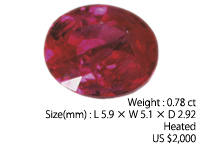CHARACTEROSTOCS BY COUNTRY OF ORIGIN
According to the book Precious Stones, written by the German gemologist Max Bauer and published in 1896, the Mogok region of Burma (Myanmar) was historically the main source of ruby, with Thailand and Sri Lanka not considered important due to the low quality and small quantities of ruby found there. However, production of Mogok ruby was severely curtailed by the change of government in the early 1960s and the subsequent nationalization of mining operations. Thai ruby (including material from Pailin in Cambodia, near the Thai-Cambodia border), which had been considered to be of inferior quality, was given a second look. The new appreciation of Thai ruby was aided by advances in heat treatment techniques that improved their color.
Starting in 1993, rubies from the Mong Hsu region in Myanmar established themselves competitively in the marketplace, eventually replacing Thai rubies as the market leader. Ruby is also found in East Africa and Vietnam.
|
 |
Mogok (Myanmar)
When exposed to ultraviolet light, most Mogok rubies emit a strong fluorescence. This characteristic gives Mogok ruby a soft, slightly purplish hue not seen in stones from other sources. However, large stones of gem quality are scarce, and prices of stones over 5 carats will far exceed that of comparably sized diamonds. Much material is currently taken to Bangkok, Thailand for polishing. |
|
Thailand
The main Thai ruby mines are located in the Klung area of Chanthaburi, Thailand and in the Pailin area of Cambodia. Much of the material mined is too light or dark in color, or lacking in transparency. With recent advancements in heat treatment techniques, however, it has become possible to improve color by, for example, making a stone less black, and the number of commercial-quality stones has increased dramatically. In jewelry and accessory qualities, stones are now being cut to calibrated sizes, so they are more convenient for use in rings and the like. |
 |
Sri Lanka
Rubies from Sri Lanka are often light in color, but on rare occasions stones that compare favorably to the Mogok material have been mined. In addition, many of these light-colored rubies are very transparent and attractive. Shown here is a Sri Lankan ruby with a tone of 3, good transparency, and sufficient brilliance-making it, in my opinion, more attractive than a Thai ruby with a tone of 6 or more. Note that Sri Lanka is also a very important source of sapphire. |
|
 |
JUDGING QUALITY
When judging Mogok rubies, it is important to understand the beauty grade of the quality scale. One can see that an S grade has a brilliant, attractive color, while a D has low transparency and insufficient beauty. Higher prices are often placed on stones that can be called ruby, but it is appropriate to recognize that translucent stones are less beautiful than transparent ones.
On the other hand, opinions differ as to how dark of a color is considered the finest. In a random survey of 300 persons (150 men, 150 women) regarding color preference in ruby, sixty percent preferred a tone of 6, thirty-five percent chose tone 5, and five percent preferred tone 4. Allowing that each gemstone is different and personal tastes vary, a ruby with an S grade and a tone somewhere around the border between 6 and 5 is traditionally the most preferred. Considering the beauty of the stone when set in jewelry or viewed under evening lighting, however, an S grade with its lighter tone of 5 or 4 may be regarded as optimum.
|
| |
|